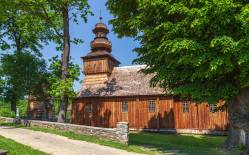The church of St. Bartholomew was built in 1600, and then over the centuries it was altered and restored a number of times.
The log church is oriented towards the East, and comprises a post-and-frame tower, a post-and-beam vestibule as well as a brick sacristy, which was added later. The nave is covered with a double-pitched roof and the chancel with a slightly lower three-pitched roof. The roof over the nave features a neo-Baroque turret. The tower with tapered walls, comprises a top chamber, and is clad with wood boards, and topped with a bulbous cupola.
Inside there is a coved ceiling, and barrel vault in the sacristy. The gallery is supported by four pillars. The entrance from the chancel to the sacristy is framed with ogee arch. The doors to the side of the nave feature the reinstalled Gothic fittings and a hammered lock from ca. 1600.
The Baroque and late Baroque furnishings inside include the high altar from the 1700s, two side altars at the entrance to the chancel from the 1600s, a unique pomegranate-shaped pulpit from the 1700s, as well as a Baroque chalice-shaped baptismal font made from black marble from the 1700s. The benches from 1756 are embellished with painted representations of the Apostles, representatives of various social strata, and scenes from the New Testament. The late-Baroque confessional, dating from the same time, is also decorated with paintings.
In Rogi, there once was a fortified castle, and relics of the ramparts can still be seen here. A reference to the castle, dating from 1462, can be found in a document related to the division of the estate between Czarnocki brothers. According to the document, the stronghold had two towers.
Photo: Krystian Kłysewicz
Gallery

Recommended venues on the Trail







This website has been modernized with the financial support of the European Union under the Cross-Border Cooperation Programme Poland-Belarus-Ukraine 2014-2020. The responsibility for its content lies solely with the Podkarpackie Regional Tourism Board and cannot, in any case, be treated as a reflection of the position of the European Union, the Managing Authority, or the Joint Technical Secretariat of the Cross-Border Cooperation Programme Poland-Belarus-Ukraine 2014-2020.









